| Aviation History And Aircraft Photography |
Virtual Aerospace Museum Tours
Glenn L. Martin Maryland Aviation Museum
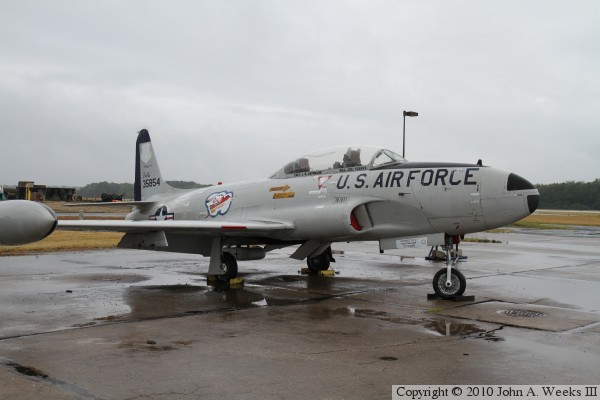
I visited the Glenn L. Martin Museum on a rainy day in July, 2010. The key
thing you learn is that Martin was a man of vision. His first company
merged with the Wright Brothers company to become Wright-Martin. His
second company morphed into Martin Marietta, and later merged with Lockheed
to become Lockheed Martin. Some engineers that got their start in aviation
include William Boeing, Donald Douglas, Lawrence Bell, and James McDonnell,
all of whom founded companies bearing their names.
The photo above is a Lockheed T-33 Shooting Star. The T-33 is a two seat
version of the P-80, the first successful US jet fighter. While the P-80
had a relatively short career, the T-33 flew for decades as a trainer, and
many are still active today in private hands. This example carries
markings from Niagara Falls AFB in New York.

Just as Glenn Martin was a man of vision, so are the members of the Glenn
Martin Museum. They have plans to establish a large regional air museum
along the waterfront near the historic ramp where Martin seaplanes were once
launched into the Chesapeake Bay. In the mean time, they have established
an interim museum in a hangar at Martin State Airport, and they have
assembled a group of display aircraft by scouring boneyards.
The photo above is an RF-84 Thunderflash, a recon aircraft manufactured on
the airframe of an F-84 Thunderjet. This Thunderflash is one of 20 that
deployed to France for 10 months during the Berlin Crisis in 1961.
Note—the Glenn L. Martin Museum has one additional aircraft that is
not pictured here, a F-101 Voodoo, and several aircraft that are not on
display. This includes a F-9F Cougar, a F-5, a Martin Mauler, and the remains
of a Maritime P6M-2 Seamaster jet seaplane.
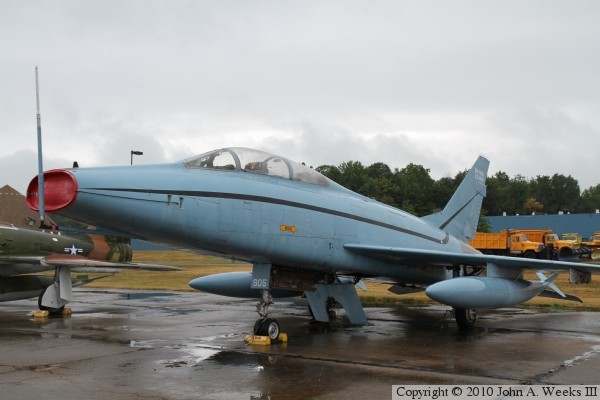
This F-100 Super Sabre, manufactured by North American Aviation, is an early
supersonic fighter. This particular version was retired to the USAF boneyard
in Tucson. It was later pulled out of storage and converted into a QF-100
target drone. Three such aircraft were pulled out of the group of 218 QF-100
and were sent to the US Army for missile testing. That explains the US Army
markings on the tail and the blue color. This example survived the missile
testing and was retired at the Aberdeen Proving Grounds. The Glenn Martin
Museum recovered the aircraft and restored it to static display status.

The Republic F-105 was the largest single engine fighter ever purchased by
the US military. It featured an internal bomb bay designed for a nuclear
weapon, but the aircraft found fame as a close air support bomber in Vietnam.
This particular F-105 is a Wild Weasel aircraft. The Weasels would work in
a hunter and killer team. The hunter would intentionally fly into SAM sites
attempting to trigger the radar, hopefully without getting shot down. Once
the radar was turned on, the killer would hit the site with a radar seeking
missile. It was dangerous work, but it was the only way to keep the missiles
in check to protect the B-52 crews. This aircraft is painted in honor of
Captain Don Carson, a weasel pilot and author. The tail number, 274, is the
number of F-105 that were shot down over North Vietnam.
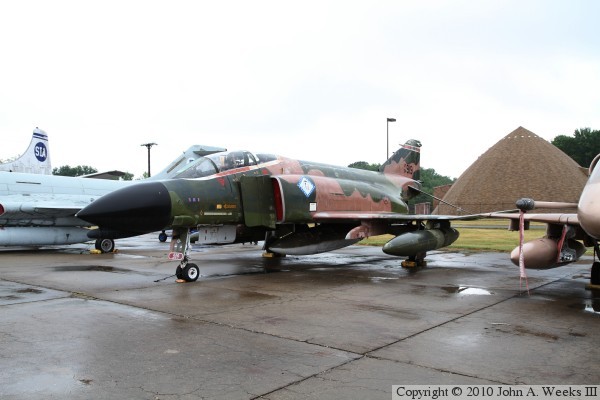
This McDonnell Douglas F-4C Phantom II was developed by the US Navy, but was
adopted as an air superiority fighter by the USAF. Despite being a very large
and heavy aircraft, it had enough power to fly Mach 2. The Phantom is a
very versatile aircraft that served in a variety of roles, and was exported
in large numbers. This example last served with the Arkansas Air National
Guard.

This is a late model Douglas A-4 Skyhawk that was developed as a trainer.
It was designated the TA-4J. The aircraft is essentially the smallest air
frame that can fit around a Pratt & Whitney J52 engine. The result is
an extremely nimble aircraft. These flight characteristics were similar to
some of the Soviet fighter jets, which lead to the TA-4J being used in the
aggressor squadrons. In fact, this Skyhawk is painted in a Soviet paint
scheme and carries a red star on its tail. This aircraft was used at the
Top Gun school in Miramar, and is reported to have been one of the aircraft
to appear in the movie Top Gun.
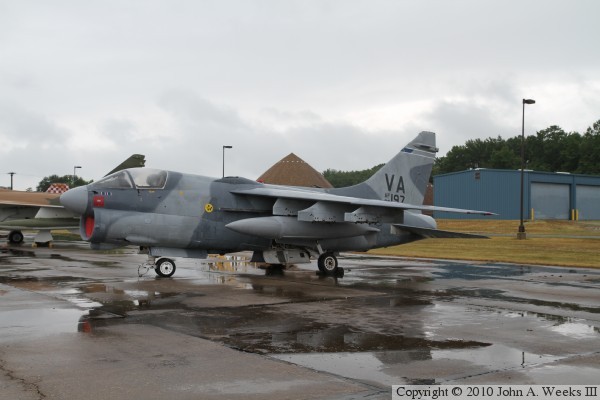
This is a Vought A-7D Corsair II. Vought built the original Corsair during
WWII, and it named the A-7 project in honor of the WWII aircraft. Both the
US Navy and USAF used the A-7. This example, a D model, was built in 1969
for the USAF. It last served in the Virginia Air National Guard based out
of Richmond. The aircraft reportedly was sent to Baltimore for an upgrade,
and it made such a hard landing at the Martin State Airport (then known as
Middle River) that the aircraft was grounded and written off. It has since
been placed on loan to the Glenn L. Martin Museum.
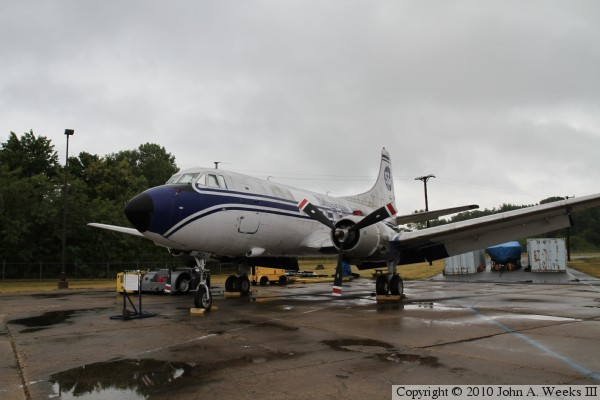
The Martin 4-0-4 airliner was produced right after WWII in an attempt to
capture a piece of the anticipated post-war travel boom. Just over 100 of
these twin engine aircraft were produced, with some going to the US Coast
Guard for patrol duty. This aircraft served a number of airlines, and was
retired in the late 1990s carrying the markings of International Airlines.
This aircraft was flown to the museum, but has been flown since that time.
It isn't in that bad of shape despite sitting for a decade. There are no
flightworthy 4-0-4's at this time, but several are under restoration,
and several more are in good enough shape to be restoration candidates.
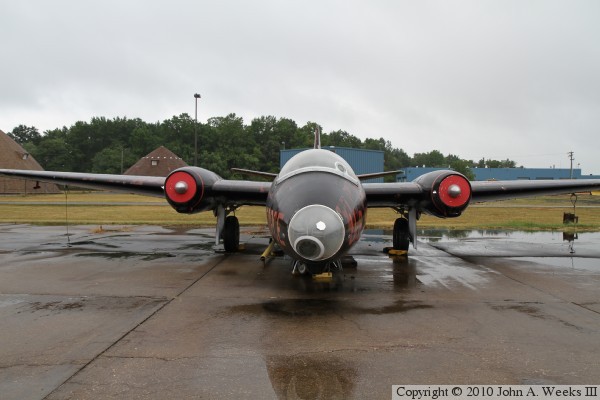
These photos above and below are two Martin RB-57A Canberra photo recon
birds. The Canberra is based on the English Electric Canberra produced
in the UK. The B-57A was not considered to be combat ready, but it was
successfully adapted to the photo recon role. Both of these aircraft were
flown by the 363rd Tactical Reconnaissance Wing based out of Shaw AFB in
South Carolina. This wing used black paint and featured the checkerboard
design on the tail as worn by the aircraft above. The aircraft below was
transferred to the Kansas Air National Guard, which used a more traditional
silver USAF color scheme. Both aircraft were rescued from the boneyard at
the Aberdeen Proving Grounds, and are on loan to the museum.
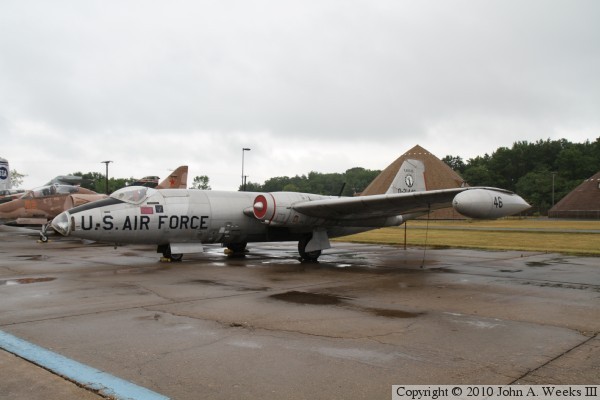
|










